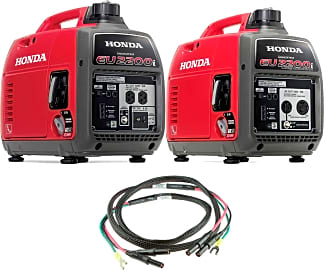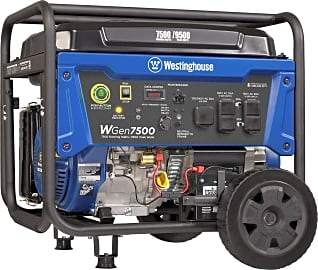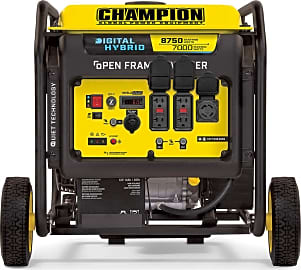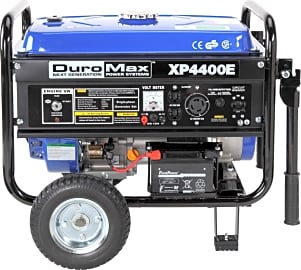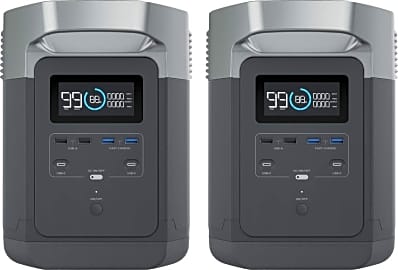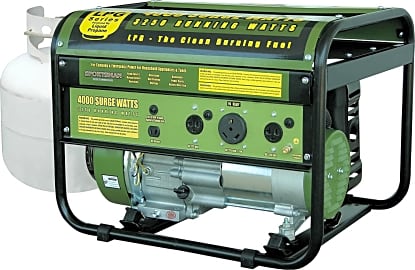The 9 Best Home Generators

This wiki has been updated 41 times since it was first published in October of 2015. Designed to provide you with reliable power on a job site, at a campground or during a blackout, these home generators will ensure that you don't get stuck in the dark. Our selections for this category include inexpensive, portable models that are ideal for keeping essential equipment in operation, as well as some heavy-duty units that are powerful enough to supply your whole house. When users buy our independently chosen editorial recommendations, we may earn commissions to help fund the Wiki.
Editor's Notes
January 22, 2021:
It wound up being an extremely busy round of updates, as widespread availability issues obliterated the bigger half of our previous picks. Models we ended up eliminating were the Webetop Camping, DuroStar DS4400, Sportsman GEN7500, Champion Power Dual, Powermate PM0497008 and Rockpals R12000ED.
Among our replacements, some notable new picks include the EF EcoFlow 2 Delta — a pair of solar generators that we included as a replacement for the Webetop Camping; the Pulsar G12KBN — a dual-fuel unit that can deliver 9,500 running watts; and the DuroMax XP15000EH — a 23-horsepower monster that most users can count on to power their entire home in the event of a blackout.
Note that, in spite of the category title, we decided to focus these rankings on portable models, as we felt that flexibility was still a valuable asset for most homeowners. If you’re in the market for a permanent installation, you might be interested in taking a look at our list of standby generators.
January 08, 2020:
During this round of updates, availability issues prompted us to remove the Chafon Backup, and we replaced the Rockpals Digital with its successor, the Rockpals R12000ED. We also added the Ford Switch & Go FG11050PBE to our list, as we were impressed by its smart design and long list of features, which make it a very similar option the R12000ED, in many ways, although its power output isn’t quite as strong.
A few key things to keep in mind for this category:
Power Output: In many, if not most, cases, this is the single most important consideration you’ll face while making this purchase. For your generator to properly backup your home, it has to have a wattage rating in excess of your home’s consumption rate. In the case of some larger homes, this might not be practical, but even then, you’ll need to determine what the essential loads are, that need to be backed up in case of an emergency (likely your fridge, furnace, stove and some lighting), and make a purchase according to that calculation. If you’ve got some basic electrical knowledge, you might be able to work that math out on your own, but if you don’t know where to begin, you might want to consider investing in an electricity usage monitor.
Portability: If this generator is destined strictly for life in your garden shed, waiting for disaster to strike, then this might not be the most relevant consideration for you. But, if you plan on doing much else with it, like say transporting it to a job site or taking it camping, then you’ll definitely want to give this some thought. Needless to say, lighter is better when it comes to carrying generators (or just about anything), but if faced with a choice between a heavy generator without wheels and a heavier generator with, you’ll almost certainly be better off with the latter. Options like the DuroMax XP4400E and the Powermate PM0601258 feature convenient wheelbarrow-style handles to help push or drag them. As do the Ford Switch & Go FG11050PBE and the Rockpals R12000ED, which also include solid tires – which are nice if you’re moving through job sites full of discarded nails, where flat tires are likely to occur.
If portability is considerably important to you, and you're only looking to power some light loads, the Honda EU2200i is a fantastic, 40-pound option that many can lug around with one arm (earning it the alias 'suitcase generator' on some construction sites). As an added bonus, it emits a bare minimum in terms of noise pollution, letting out a purr next to most generators' roar.
Versatility: What are you planning to power? While common 120-volt, 20-amp outlets seem to come standard in this category, many of our selections feature a range of outlets, allowing you to feed several types of load. The particularly-well-equipped Rockpals R12000ED features both 30-amp and 50-amp outlets, so supplying your dryer and stove won’t be a problem. The smaller Webetop Camping – which isn’t a true generator, but in fact a chargeable power source – is outfitted with three USB ports, which can come in handy for charging applications.
A Brief History Of The Electric Generator
Typically, a mechanically moving belt rubs against a conductor attached to a hollow metal globe, which stores the charge generated from the friction that ensues.
Most generators today use the power of electromagnetism to generate a current. However, the relationship between magnets and electricity was not discovered until 1831, by British scientist Michael Faraday. Nearly two centuries earlier, the first primitive generator was developed by German inventor Otto von Guericke.
Von Guericke's initial means of generating electricity relied on the use of friction. In fact, electrostatic generators were originally called "friction machines." For the most part, these could only produce sparks of electricity, rather than a steady current. Early models worked much like the Van de Graaff generators seen in science museums and classrooms around the world. Typically, a mechanically moving belt rubs against a conductor attached to a hollow metal globe, which stores the charge generated from the friction that ensues. A conducting body that comes in close contact with the sphere can generate a spark as electrons move to neutralize the charge generated in the sphere. Often, a metal wand is used for demonstration purposes. Another popular demonstration technique is to link a group of people to the machine and watch as the static electricity causes their hair to stand on end.
While friction-based generators based on designs from the 17th and 18th centuries are still used in educational settings, they can't actually power anything. Faraday's discovery of electromagnetism made the consistent generation of a current possible. He built a machine called a disk generator which capitalized on the electric potential of magnets. It used a rotating copper disc placed between the poles of a horseshoe-style magnet, and could produce a somewhat steady, if weak, direct current voltage.
There were a variety of issues with Faraday's initial design that made it inefficient, but rapid development of the design resulted in improvements that made way for contemporary solutions. These advancements included the use of additional magnets as well as using coiled copper wires to collect the charge, which produced a much higher voltage.
The resulting generators used coils of wire rotating within a magnetic field, which produce an alternating current similar to the ones we use in our homes. In general, this type of generator is called a dynamo. These were developed throughout the 1830s and first entered industrial use in 1844.
Today's alternating current generators were built on the concepts used in the dynamo, which was increasingly streamlined over the latter half of the 19th century.
Key Features Of Modern Day Generators
Today's home generators have many convenient advantages over their predecessors. For one thing, they're highly portable. Many are built on wheels and can easily fit in the average car's trunk, making them ideal for camping. Most also feature standard electrical outlets, so you can attach your appliances and devices directly. Many even have built-in batteries that charge while the generator is running and reserve power you can use once it's switched off.
A variety of fuel types can power home generators, depending on your preference. Propane is popular, as tanks are easy to purchase and exchange at many national hardware and grocery store chains. Standard gasoline and diesel are also options, though they require you fill the tank yourself. Still, gas is available just about everywhere, so you can travel with your empty generator and buy fuel locally once you've reached your destination. Natural gas-powered generators are also available.
Home generators are increasingly fuel efficient, and many let you know how just much power they have left on a given tank. This allows you to better prepare for refuels and avoid leaving yourself without power in an emergency.
A Personal Story About the Value of Electricity
When I first graduated college, I spent a month working on a farm in the south of France. The family I lived with built their house themselves with the intention of being fully "off the grid." The property was gorgeous. The house sat on stilts midway up a large hill below a small farm-town road, with fields and livestock at the bottom. The house had no electricity; a wood burning stove provided both heat and a means of cooking, and the only light sources were candles.
For a few hours each day, a stereo blared the sounds of Marilyn Manson and the Oslo-based symphonic black metal band Dimmu Borgir.
When I made the arrangements, I assumed the people I was going to stay with were locals to the area, and that it was a family farm some number of decades old. Upon arrival, I learned that this was not the case. My hosts were a British couple who had moved to France a few years earlier to escape the crowds and stresses of city life. Their crops and animals produced most of the food they consumed, but they didn't profit off of them. Instead, they were dog breeders. They were also metalheads, with countless facial piercings and tattoos all over their bodies, as well as posters of Slayer, Megadeth, and various metal bands I'd never heard of covering the walls of their home.
When I say that the house had no electricity, what I really mean is that it wasn't wired. In truth, they had a gasoline-powered generator outside, lovingly referred to as Jenny, which provided them with various means of 21st century entertainment via a long extension cord. For a few hours each day, a stereo blared the sounds of Marilyn Manson and the Oslo-based symphonic black metal band Dimmu Borgir. A Bart Simpson-shaped television glowed with scenes from old concerts and horror films on DVD. They even had a Nintendo Wii with a few games. They also had a wireless hotspot and an old laptop, which were the means they'd used to communicate with me before my arrival. They'd charge both devices while the generator was running for later use.
They could only afford to power the generator for short periods of time, so it wasn't useful for utilitarian purposes. Living there taught me that electricity is a luxury that's not actually very hard to live without. In fact, about 16 percent of the world's population lives without it entirely. For those who do have it, we should relish in the joys it can bring, and never take it for granted.



